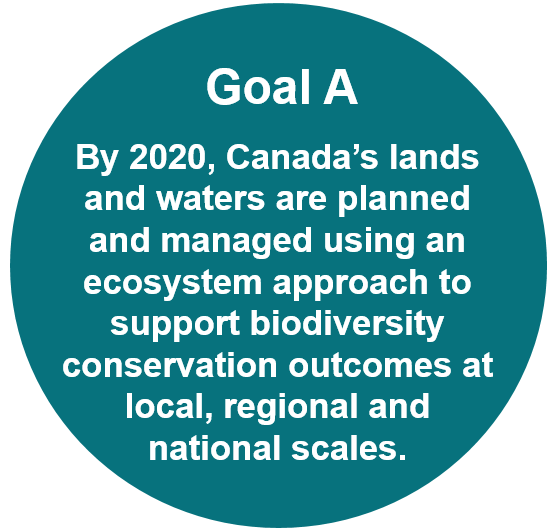Canada Target 5. By 2020, the ability of Canadian ecological systems to adapt to climate change is better understood, and priority adaptation measures are underway.
Indicators:
Completion of assessments of the vulnerability of ecological systems and biodiversity to climate change in sectors and regions across Canada that identify priority areas and species of greatest concern
The number and extent of management, land use and development plans completed and implemented that integrate explicit consideration of adaptation to facilitate or enhance the resilience and sustainable use of species and areas of greatest concern
About the Target
Climate change impacts on ecosystems continue to pose serious risks to the health, security, livelihoods, and well-being of Canadians and their communities. Wide-ranging effects of climate change are already being observed in Canada. Average annual temperatures are increasing, along with changes in precipitation, the frequency and severity of extreme weather events and natural disturbances such as fire. Landscapes and habitats are changing under climate warming including loss of ice cover and permafrost in the north and decline in ice cover throughout the Great Lakes.
These changes are affecting biodiversity and ecological systems across the country. This includes shifts in the distribution, productivity, and abundance of species, as well as altered patterns of migration, breeding, and flowering or seed set. In addition, climate change exacerbates other existing threats to biodiversity, such as habitat loss and the introduction and spread of invasive alien species.
All levels of government are working to better understand key vulnerabilities of natural systems, to assess if and how these ecosystems will adapt, and to prioritize actions that support resilience. Broad and sustained efforts underway at the federal, provincial, territorial, and municipal levels have led to significant progress in understanding the complex interlinkages between ecological systems and climate, including the ability of ecological systems to adapt. In partnership with academia, the private sector, and non-governmental organizations, governments are also working to develop effective adaptive measures including tools and guidance to address the most pressing impacts on priority areas and species of concern.
Initiatives already aimed at protecting and restoring biodiversity - such as conservation areas, protected corridors and sustainable natural resource use practices - can enhance the resilience of Canada’s natural capital. This work needs to be informed by improving knowledge about climate-driven changes in ecosystems. As viable habitats shift, for example, it will be important to consider expanding and enhancing landscape and seascape connectivity using ecological corridors between parks and refuges, protecting species while providing habitat and services for nature and people.
Considering the important connections between Indigenous communities and the land, water, and ice, Indigenous Knowledge is vital to understanding how climate change is affecting ecosystems and to the design and implementation of approaches for their preservation and management.
Canada Target 5 is linked with the following global Aichi target under the United Nations Convention on Biological Diversity Strategic Plan for Biodiversity 2011-2020:
Aichi Target 19 - By 2020, knowledge, the science base and technologies relating to biodiversity, its values, functioning, status and trends, and the consequences of its loss, are improved, widely shared and transferred, and applied.
2020 Final Assessment
There is ongoing research and assessment of the impacts of climate change on biodiversity and efforts to implement adaptation measures. Some more current work has taken place since the 6th National Report (see Contributing Actions).
The target has been met given that there has been improved understanding of the adaptation capacity of some ecosystems based on some adaptation measures underway. This is an ongoing process and there is a need to continue to gather data on how extensive adaptation measures are across the country, and in different ecosystem types, and what cross section of conventional (such as expanding the protected areas network and increasing connectivity) and interventionist (such as assisted migration and triage-based conservation) measures exist or are needed. Coordinated efforts are needed to answer these questions and guide ongoing work. Canada’s National Adaptation Strategy and the National Climate Change Science Plan, both include strategies and priority actions for biodiversity and ecosystems to ensure a comprehensive and consistent approach. These efforts aim to cut pollution, create more jobs, support a healthier economy, and a healthier environment.
Contributing Actions
In December 2020, the Government of Canada committed to develop Canada’s first National Adaptation Strategy with provincial, territorial and municipal governments, Indigenous peoples, and other key partners. The strategy has established a shared vision for climate resilience in Canada, identified key priorities for increased collaboration and established a framework for measuring progress at the national level. Expert Advisory Tables have informed the development of the strategy including via the Thriving Natural Environment and the Resilient Natural and Built Infrastructure tables.
In December 2020, the Government of Canada also published Climate Science 2050 Advancing Science and Knowledge on Climate Change, “a national synthesis to better understand the breadth of Canadian climate change science and knowledge gaps.” This includes identifying knowledge gaps and needs to further understand the relationship between climate change and nature.
Canada and Mexico co-led on the Nature-Based Solutions (NBS) Action Track in partnership with international partners. The action track was designed to accelerate the uptake of nature-based solutions for climate adaptation, by profiling the leadership of countries and cities, as well as by identifying innovative approaches for financing these solutions and engaging Indigenous peoples and youth to learn from their perspectives.
Canadian Parks Council Climate Change Working Group developed a Climate Change Adaptation Framework for Parks and Protected Areas. This framework was subsequently adapted by Parks Canada through a multi-day adaptation workshop approach, with 13 workshops held from September 2017 to March 2020 with staff, partners and collaborations from sites administered by Parks Canada in the Yukon, British Columbia, Alberta, Saskatchewan, Manitoba, Ontario, Quebec, Nova Scotia, and Newfoundland and Labrador.
With support from the Great Lakes Protection Initiative (GLPI), Environment and Climate Change Canada is working on climate change adaptation through a project called Assessing and Enhancing the Resilience of Great Lakes Coastal Wetlands. The purpose of this five-year project (2017-2022) is to develop tools that build on the current understanding of coastal wetland processes, structure, and composition in order to: identify future climate change impacts, understand how and where wetlands are most vulnerable to the impacts of climate change and bring together all levels of government, Indigenous peoples, experts and decision makers, businesses and community groups to develop proactive adaptive strategies and measures for building coastal wetland resilience in the Great Lakes basin.
The Climate Change Adaptation Community of Practice (CCACoP) is an interactive online community dedicated to advancing knowledge and action on climate change adaptation. The CCACoP serves as a location where researchers, experts, policymakers and practitioners from across Canada can come together to ask questions, generate ideas, share knowledge, and communicate with others working in the field of climate change adaptation. One of the main goals of the CCACoP is to support all Canadian provinces and territories in their efforts to incorporate climate change adaptation into planning and policies.
The Forestry Adaptation Community of Practice (FACoP) is an interactive online community for sharing information and best practices on climate change vulnerability and adaptation in Canada’s forest sector. It is supported by the Canadian Council of Forest Ministers’ Climate Change Working Group.
The Forestry Adaptation Working Group (FAWG) facilitates knowledge sharing amongst forestry stakeholders, including federal, provincial, and territorial governments, industry, academia, and other non-governmental organizations to promote climate change adaptation within Canada’s forest sector and communities.
In 2019, Natural Resources Canada’s Canadian Forest Service released a 10-year national forest research agenda (2019–2029) to address the effects of climate change on Canada’s forests and forest communities.
Fisheries and Oceans Canada supports funding to third parties to undertake aquatic restoration activities that improve the resilience of Canada’s aquatic ecosystems to climate change.
AdaptWest is a spatial database designed to help land management agencies and other organizations across North America implement strategies that promote resilience, protect biodiversity, and conserve and enhance the adaptation potential of natural systems in the face of a changing climate.
British Columbia’s Living Lab Program promotes protected areas as places to learn about the effects of climate change. The program encourages research in protected areas to help us understand how undeveloped ecosystems react to climate change. Research in parks can also tell us how land and water connectivity between parks will make a difference for species as the climate changes. This kind of information will help when making decisions on what actions to take both inside and outside parks.
One adaptation strategy is to focus conservation on climate-change refugia (i.e., areas relatively buffered from contemporary climate change over time). Work based at the University of Alberta (BEACONs Project) explores how to identify and protect climate refugia in boreal North America, a region at the frontlines of climate change.
The Ontario Ministry of Natural Resources and Forestry has produced a series of science reports related to climate change and the vulnerability of species and ecosystems. In 2018, the reported results of Ontario’s multi-year project to assess climate change vulnerability of species in the Ontario Great Lakes Basin supports the development of adaptive conservation strategies. The work used NatureServe’s Climate Change Vulnerability Index (CCVI). A related 2019 study discusses how metrics associated with the pace of climate change can be used to inform protected areas planning and biodiversity conservation in Ontario.
Crown-Indigenous Relations and Northern Affairs Canada (CIRNAC) operates the Climate Change Preparedness in the North Program funding climate change adaptation projects in Yukon, Northwest Territories, Nunavut, Nunavik and Nunatsiavut. The program works with Indigenous and Northern communities, territorial and regional governments, and other stakeholders to identify priorities for climate change adaptation in the North. With respect to wildlife and ecosystem health, the program has supported assessments which help identify climate change impacts on culturally important plant species in the Yukon, detecting the expansion of beaver habitat in Nunavik, and the level of risk that arthropod-borne zoonosis pose within the Northwest Territories.
A study of tree cover in Montreal shows that the diversification of urban trees based on a functional group approach is an effective adaptation strategy for increasing the resilience of the urban forest cover to climate change.
Health Canada published Reducing urban heat islands to protect health in Canada, which explains that urban heat, exacerbated by climate change, can be alleviated through naturally inspired design choices. These solutions may involve actions or designs that mimic, enhance, or support the functions of a natural system. Examples include building a wetland to help regulate floods and improve water quality, or planting street trees to provide cooling. Beyond the intended objective of many nature-based solutions, there are often additional benefits for human and environmental health. The Nature Conservancy of Canada is running a climate change adaptation strategy to promote ecological corridors in five Quebec regions and build a common vision for connectivity in southern Quebec.
Nature-based approaches to adaptation
The objective under Target 5 is the ability of ecosystems to adapt to climate change. However, conserving biodiversity also helps society adapt to climate change. Multiple benefits can be gained through the use of nature-based approaches, for both climate change adaptation and emissions reduction, including:
Reduced impact of flooding;
Reduced impact of urban heat islands;
Protection from storm surges and saline intrusion;
Provision of habitat and biodiversity preservation;
Carbon sequestration;
Protection against erosion;
Drought mitigation;
Regulation of water flow and supply;
Improvement of place attractiveness;
Improvements to physical and mental health, well-being and quality of life; and,
Creation of green jobs.

